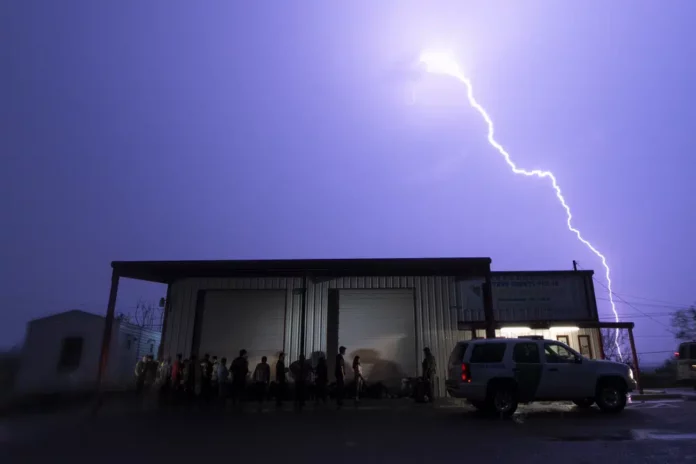
The number of migrants encountered at the southern border fell 50% during the last three days compared with the days leading up to the end of a key pandemic-era regulation, U.S. officials said Monday.
But a high number of migrants are still in U.S. custody, although the number has fallen “significantly” since last week, said Blas Nunez-Neto, assistant secretary for border and immigration policy at the Department of Homeland Security.
The ability of U.S. Border Patrol to hold migrants has been a key concern as more migrants came to the border in the days leading up to the end of immigration restrictions linked to the pandemic, referred to as Title 42. The administration is facing a lawsuit aimed at curtailing its ability to release migrants from custody even when facilities are over capacity.
At one point last week, more than 27,000 migrants were in custody along the border, a number that may top 45,000 by the end of May if the powers to more quickly release migrants from custody when facilities are over capacity are curtailed, said Matthew Hudak, deputy Border Patrol chief, in a court filing last week related to the lawsuit.
Nunez-Neto said border officials had been encountering a little less than 5,000 people a day since Title 42 expired at midnight Thursday, and new U.S. enforcement measures went into effect Friday. He did not give exact numbers.
“It’s still too early to draw firm conclusions. We are closely watching what’s happening. We are confident that the plan that we have developed across the U.S. government to address these flows will work over time,” said Nunez-Neto.
He credited the U.S. planning as well as enforcement measures Mexico and Guatemala have carried out in recent days along their own southern borders. He gave no details about what those two countries were doing.
The head of the U.S. Border Patrol, Raul Ortiz, said on Twitter on Monday that his agents had apprehended 14,752 people over the past 72 hours; that averages out to 4,917 per day.
The figures given Monday are sharply below the 10,000-plus encountered on three days last week as migrants rushed to get in before new policies to restrict asylum took effect.
Title 42 allowed U.S. officials to quickly expel migrants without letting them seek asylum, but it also carried no consequences for those who entered the country and were expelled. In the leadup to the end of Title 42, the U.S. introduced tough enforcement measures to discourage people from just arriving at the border, encouraging them instead to use one of the pathways the U.S. has created to facilitate migration.
Many migrants, worried about these tough enforcement measures, came before Title 42 expired.
The U.S. is in litigation about whether it can release migrants without what’s called a “notice to appear.” Usually, migrants who are released into the United States — as opposed to those held in custody or immediately expelled — get a “notice to appear,” which includes a court date and some type of monitoring with immigration officials. But it can take up to two hours to process a single person for this, potentially choking Border Patrol holding facilities when they’re at capacity.
Since 2021, the U.S. has often released migrants from custody with instructions to report to an immigration office in 60 days. It’s a process that takes only 20 minutes, but it’s come under attack by those who say it doesn’t offer enough oversight. On Friday, a Florida court temporarily put an end to the process; the administration is appealing that decision. On Monday, the judge, in a preliminary injunction, narrowed the order so it only applies to migrants who say they plan to stay in Florida until their court hearings.
In court filings last week, U.S. authorities said they cannot confidently estimate how many people will cross the border. Hudak said authorities predict arrests will spike to between 12,000 and 14,000 a day. Hudak also noted that intelligence reports failed to quickly flag a “singular surge” of 18,000 predominantly Haitian migrants in Del Rio, Texas, in September 2021.
Republished with the permission of The Associated Press.













